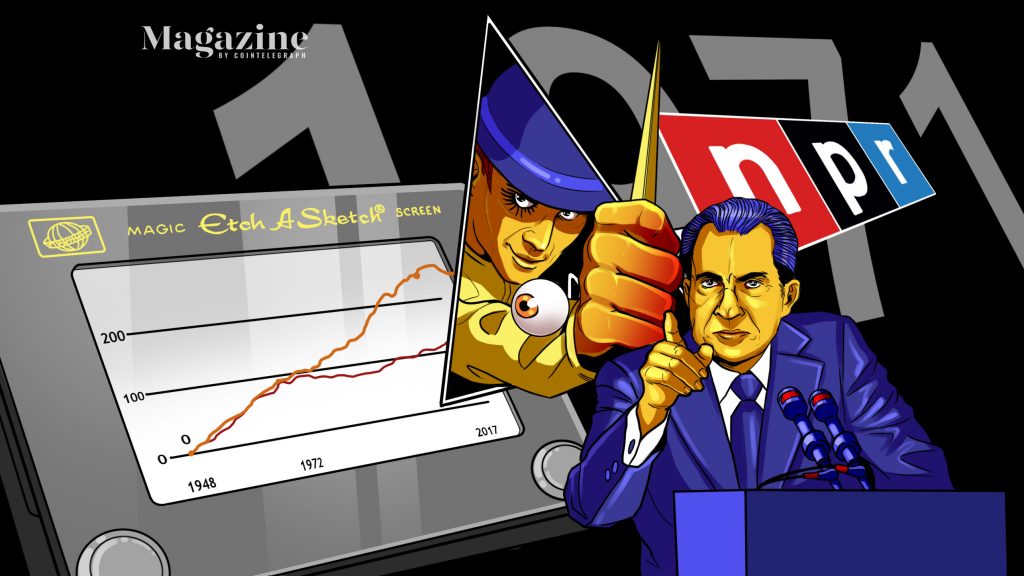
On Oct. 1, 2019, Cointelegraph Magazines founding editor, Jon Rice, pressed publish on the first-ever feature story for the publication a story by Swedish fintech writer Jinia Shawdagor about the countrys embrace of a cashless economy.
The brainchild of former Cointelegraph CEO Jay Cassano who was managing editor at the time Magazine was designed to fill a major gap in crypto media with in-depth features exploring all angles of the issues in a thoughtful, considered way. While its easier to get traffic writing breathless stories about Bitcoin price predictions, Magazine is an attempt to give readers and the industry a more intelligent approach.
I came on board after meeting the team at Cointelegraphs conference in Singapore. Due to an amusing mix-up between Austria (where a story they wanted to cover was based) and Australia (where I actually live), I was commissioned to write Magazines seventh-ever published article, Blockchain startups think justice can be decentralized, but the jury is still out.
This stroke of good fortune led me to become a staff writer, and later to take over as editor after Rice moved on (hes now editor-in-chief of Blockworks). Three years on, Magazine has amassed a great team of regular contributors, including Blockland author Elias Ahonen who joined after being interviewed for a story on physical Bitcoin Andrew Singer, Max Parasol of the RMIT Blockchain Innovation Hub, Christos Makridis of Stanford University, and freelance crypto writers Jillian Godsil and Julian Jackson. Magazine is always looking for more contributors, so if you would like to write for the publication, get in touch.
Without further ado, here are some of the highlights (and a couple of lowlights) of the first three years of Cointelegraph Magazine.
Andrew Fenton, Cointelegraph Magazine editor

The most popular stories
WTF happened in 1971 (and why the f**k it matters so much right now)
The most consistently popular story on the site explores whether former U.S. President Richard Nixons decision to get rid of the gold standard, which backed U.S. dollars with gold, caused a host of social and economic problems. Since 1971, productivity increased while wages flatlined; GDP surged, but the share going to workers plummeted; and house prices went through the roof. Is it causation or merely correlation?
How to prepare for the end of the bull run, Part 1 and Part 2
Essential reading before the next bull run, we spoke with some of the most respected pundits in crypto including Filbfilb, Mati Greenspan and Scott Melker about how to play the inevitable crash. TLDR: Always take profits on the way up.
Toss in your job and make $300K working for a DAO? Heres how
Nataliya Ilyushina and Trent MacDonald transformed their own academic research into a fascinating article about how some of the employees involved in the great resignation transformed their lives by working for DAOs. (Readers also flocked to our similar explainer on how to set up a DAO, How to bake your own DAO at home With just 5 ingredients!)
Childs play: Gajesh Naik, 13, manages a fortune in DeFi
The headline says it all: A 13-year-old kid from Goa in India is managing a million-dollar DeFi platform. Would you trust a seventh grader with your life savings?

5 big questions answered
Can Bitcoin survive a Carrington Event knocking out the grid?
Should crypto projects ever negotiate with hackers?
What really goes on at a crypto OTC desk?

10 great features
The FBIs takedown of Virgil Griffith for breaking sanctions, firsthand
Author Ethan Lou attended the infamous North Korean crypto conference alongside Ethereum developer Virgil Griffith, who is now serving five years in prison for helping the country evade sanctions using crypto. Lous article portrays Griffith as so dangerously naive that he volunteered much of the evidence the FBI used to convict him.
Ethereum is eating the world You only need one internet
Zero-knowledge proofs and recursive scaling mean the entire worlds financial system could theoretically run on Ethereum. Reader feedback was very positive, with many commenting this was one of the few things ever written about zk-Rollups that attempted to explain it in simple terms for ordinary people.
NFT art revolution: Beeple on his 5,040-day labor of love
Magazine profiled NFT artist Beeple shortly before he found global fame for auctioning his Everydays work for $69 million. He already knew it was going to be a big deal, telling Magazine it was Christies first totally digital auction and that it would accept Ether. There will be no physical piece; theyre literally just auctioning off a JPEG. And so, I think that will be a very big moment, and big validation for this space.

The lizard people invented Bitcoin: Crypto is a hotbed for conspiracy theories
With the pandemic getting into full swing in 2020 and paranoia running rampant on Crypto Twitter, Magazine decided to find out why crypto fans are drawn to conspiracy theories. It turns out there are some very good reasons, not least because there really are shadowy actors manipulating events behind the scenes in crypto.
How Silk Road made your mailman a dealer
One of Magazines earliest published stories explores how Bitcoin came to public attention after being adopted for use on the darknet marketplace Silk Road. Containing a detailed first-person narrative on how one actually bought drugs or other illegal stuff on the darknet, its perhaps not surprising that the author remained anonymous.
The crypto effect: Trading altcoins at the edge of addiction
Photojournalist Matt Danzico looked at how traders were spiraling into addiction and the emerging treatment options to wean them away from their next crypto rush.
Block by block: Blockchain technology is transforming the real estate market
Imagine owning a token representing a two-millionth share of the Empire State Building. Analysts say that tokenized real estate could be worth $1.4 trillion if it captures just half a percent of the global property market.

Is Ethereum left and Bitcoin right?
Does the battle between conservative Bitcoiners who want to preserve the best money in history and progressive Ethereans who want to push things forward mirror our divided political culture? Yes, it does.
Soulbound Tokens: Social credit system or spark for global adoption?
When Ethereum co-founder Vitalik Buterin unveiled his Soulbound Tokens paper, there was a lot of heat but not much light shed on how theyd actually work in practice. Magazine spoke with Buterins co-author Glen Weyl to get the lowdown on this important new development.
Crypto kids fight Facebook for the soul of the Metaverse
Meta is throwing everything it has into dominating the Metaverse like Facebook dominated social for so long, but Web3 proponents are fighting to make it open source and decentralized.

Most fascinating people
Dmitry Buterin: Vitalik Buterins dad revealed his own fascinating life story as a computer scientist and entrepreneur who left Russia to make it in Toronto. He spoke about raising Vitalik, psychedelics, libertarianism and philosophy.
Damien Hirst: Magazine spoke with the legendary British artist in his West London studio ahead of the launch of his innovative The Currency NFT project.
Roger Ver: Bitcoin Jesus dropped a bombshell that rather than go to prison in 2002 for selling firecrackers, hed considered killing himself to be cryogenically revived at a later date.
Peter McCormack: The podcaster told a story about how his flirtation with using Bitcoin to buy cocaine on Silk Road left him hospitalized and how he made and lost a fortune twice.
David Chaum: The crypto pioneer whose work inspired the cypherpunks told Magazine about how he risked a lifetime in jail laying the foundation for Bitcoin.

Carl The Moon Runefelt: The social media influencer genuinely believes that he manifested his crypto wealth simply by believing he would get wealthy, recalling the premise of the pseudoscientific bestseller The Secret.
Tim Draper: The former Bitcoin billionaire (down to half a billion now) shared his tips for investing success and his glass-half-full philosophy. Instead of looking for what could go wrong, he thinks: What if it works and something really extraordinary happens?
Lushsux: The controversial Melbourne street artist has been engaged in strategic trolling for a decade now and more recently began to make a name for himself and a small fortune with NFTs.
Chris Blec: DeFis loudmouth troublemaker is a decentralization maxi. Is he good or bad for decentralized finance?
Griff Green: The DOGE-loving hippy white hat hacker who quickly replicated The DAO hackers exploit to steal as much of its Ether before the hacker could get away with the lot.

The worst: Rogues gallery
January and February 2021 were something of a low point for Magazine, as three profiles of industry figures came out in quick succession who went on to become the biggest crypto villains of 2022: Celsius founder Alex Mashinsky, FTX and Alameda founder Sam Bankman-Fried and Member of the European Parliament Eva Kaili who was recently charged after investigators allegedly found bags of cash from bribes in her apartment.
Reading them back, the Mashinsky profile from January 2021 stands up okay and included criticism of the firms abrupt $20 million raise, the absurd cult around him, rumors Celsius was taking risks, and a choice quote from podcaster Peter McCormack, who said the blokes a weirdo and he needs to get his act together.
A month later, the SBF profile was far too willing to take his effective-altruism spin at face value and likened it to robbing from the rich to give to the poor. Maybe without the robbing part, Bankman-Fried said, without a trace of irony. In reality, prosecutors say he was robbing from the poor FTX users so Alameda could make risky bets.
That same month, the biggest crypto proponent in the European Parliament, Kaili, possibly shed light on why she might prefer (alleged) cash bribes to crypto ones, telling Magazine that between me and you, I think the best way to get the ones that want to tax-evade is to put them on blockchain, because nothing is ever gone forever.

Best of the global coverage
While much of crypto media is focused on the U.S., Magazine has made a conscious effort to report on the best stories from around the world.
In Georgia, crypto is a crucial tool for refugees escaping the war
Cointelegraphs European editor Aaron Wood relocated from Saint Petersburg in Russia to Tbilisi, Georgia at the start of the Ukrainian invasion. He shared the story of how Russian refugees used crypto to move assets across borders and stayed afloat by trading crypto for cash at Tbilisis physical exchanges.
Crypto in the Philippines (Part 1) and The ethics of hiring cheap Filipino staff (Part 2).
The first part of our series looked at crypto adoption in the Philippines, while the second looked at the ethics of crypto projects hiring cheap Filipino labor. The latter story was named one of the best articles of the month in February 2021 by the Association of Cryptocurrency Journalists and Researchers.
Inside the Iranian Bitcoin mining industry
Tehran-based journalist Saeed Jalili went deep inside the Iranian Bitcoin mining industry, which is dominated by illegal, underground mines.

Thailands Crypto Utopia 90% of a cult, without all the weird stuff
Magazine visited Thailand to cover the crypto digital nomad scene and stumbled across this insane story about how Bitcoin OG Kyle Chasse set up a libertarian Bitcoin commune. The tale involved unchecked merrymaking, crypto influencers, police grillings, seasteading, a reported $20,000-a-month burn rate and a major collision between idealism and reality.
What its actually like to use Bitcoin in El Salvador
Joe Hall spent two weeks in the Central American country trying to pay for everything with Bitcoin. It didnt work out so well, even at Bitcoin Beach.
Our popular China-based crypto news round-up from Our Man in Shanghai ran throughout 2021 but was put on ice following the great China crypto crackdown. Its returning soon with a wider focus on Asia and a new writer who isnt physically based in China and, as such, doesnt need to fear repercussions for speaking their mind.
Magazines guides to the crypto history, businesses, meetups, services and education in cities around the world kicked off with Melbourne (Australia) in August 2021. It has since visited Vancouver (Canada), San Francisco (U.S.), Prague (Czech Republic), Miami (U.S.), Dubai (UAE), Austin (U.S.), New York (U.S.) and Tokyo (Japan).





